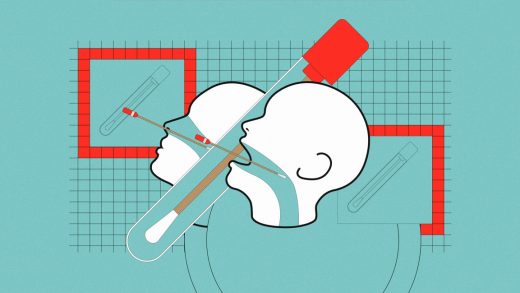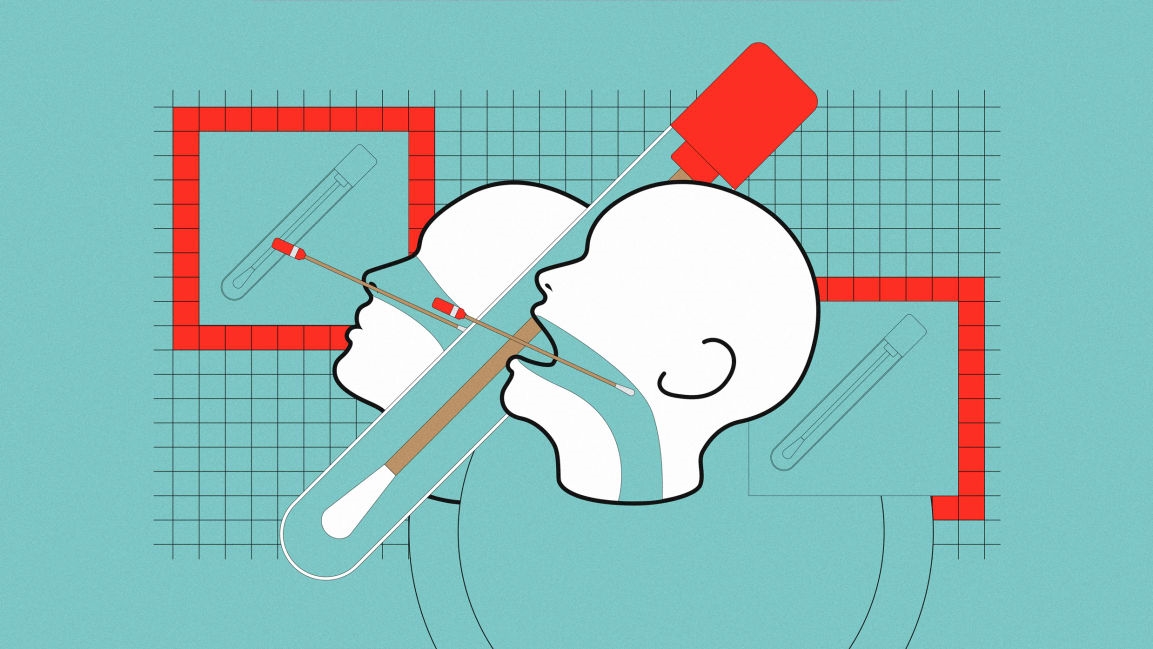What you need to know about throat swabbing for COVID-19 rapid tests
It didn’t look like Zachary Dupin, 31, would miss out on Christmas. Despite a sore throat, he says he tested negative, twice, on PCR tests, and once on an at-home rapid antigen test. But still feeling unwell after driving home from Reno to Las Vegas, he did another rapid test that came back negative, but still decided to isolate in a hotel near home and self-tested once more—but this time he swabbed his throat. And this time he tested positive. He and his brother, who also tested positive orally, spent the holidays in the hotel, catching up on reading, watching college football games, and, thankfully, getting some home-cooked food deliveries while fending off fatigue, dry cough, and dizziness. The test had narrowly saved them from potentially infecting the rest of the family.
Dupin is one of many everyday social media users who’ve publicly shared their—admittedly anecdotal—positive COVID-19 detections via throat swab, after a nasal negative. There’s certainly room to poke holes in the stories: Dupin could have simply become infectious between the tests. But the idea is also coming from biologists, immunologists, and epidemiologists, who recommend adding the throat dab to the nose swirl. Some researchers who’ve studied the throat swab method agree, having seen indications that the omicron variant might be better detected orally. But other scientists remain saliva skeptics, saying it’s the surge in at-home tests that has led to a spike in anecdotal detections—and that using the test in ways not prescribed could render them ineffective. They agree that more research would be valuable, especially since the “double-dip” has been routine in other countries from the start. But what research would persuade the U.S. Food and Drug Administration to approve using throat swabs on the test remains to be seen.
Dab and swirl
At the start of the pandemic, the gold standard for tests was the eye-watering nasopharyngeal swab. For most of us, it’s not a fond memory: tilting your head, ready for the extra-long Q-tip to wedge an inch deep into your nostril to reach the nasopharynx, where the nose meets the upper throat. In summer 2020, the more palatable nostril (“anterior nares”) test largely replaced it, where the swab goes upward into the nose and takes a few shallow swirls. In the U.S., for both PCR tests and the recently ubiquitous at-home tests, the nasal swab is now the norm.
Many other countries have long complemented the nasal swab with a throat swab, known as an oropharyngeal test. That includes the U.K., where people taking rapid antigen tests (known there as lateral-flow tests, for the liquid sample that flows along the strip to indicate a result) are instructed to swab both their throat and nostrils. The official government instructions tell at-home users to avoid food and drink for 30 minutes prior to dabbing the back of the throat with the swab, four times on both tonsils (or the uvula, the fleshy punching bag that dangles above the throat); then, with the same Q-tip, to take 10 circles in a single nostril. Australia, and some provinces of Canada, give similar guidance for at-home tests.
But only recently have at-home antigen tests become accessible in the U.S., representing the first time most people have dabbed their noses. Dr. Sanjat Kanjilal, attending physician in the division of infectious diseases at Brigham and Women’s Hospital in Boston, says this novelty might be part of the reason Tweeters and TikTokers are noticing the trend, rather than omicron being any more effectively detected by throat swabs versus past variants, given the tests weren’t around then. “My suspicion is that what we’re seeing is anecdotal bias, and not something real,” he says.
Kanjilal offers an explanation, based on biological insight rather than clinical data, for why people are getting false negatives in the nose at first. As before, people are usually testing when they have symptoms. But for people who are vaccinated or have prior immunity, symptoms seem to be appearing a few days earlier with omicron, while the viral load path remains the same: Heavier, detectable volumes don’t appear until a bit later. So rapid tests, which are less sensitive than PCRs, may not be picking up the smaller initial load. He notes that at his hospital, where regular surveillance testing is done, as opposed to only when people have symptoms, the detection efficacy has not changed.
Though he does also concede that because a prevalent symptom of omicron is a sore throat, most of the viral burden is likely located in the throat at first, and that in the same way that streptococcus tests are throat swabs, because strep lives in the throat, a throat swab could now be beneficial. That would signal a shift from early studies, before omicron, that found oropharyngeal tests were less reliable than nasopharyngeal ones.
Slim swabs and the “Spit Queen”
The Centers for Disease Control and Prevention has approved PCR tests to be performed on oral samples, and Dr. Amy Mathers, associate director of clinical microbiology at University of Virginia Health, says it’s actually quite common, including at UVA Health. The practice stemmed simply from a shortage of the slim swabs needed for nasopharyngeal tests (easier to slot deep into the nose) early in the pandemic. Staff had to get creative. They did have the bigger swabs, used for nasal or throat swabs. Oropharyngeal tests became the go-to. “I was like, this is heresy—a respiratory virus that we’re going to get from a throat?” she says. But they proved effective. “There’s so much COVID in your upper respiratory tract. It’s pretty easy to pick up.”
Anne Wyllie, an epidemiology research scientist at Yale University’s School of Public Health, believes that omicron might be lending itself better to oral detection. She studies another type of saliva test, slightly different from throat swabs, for which patients “drool into a tube.” Both of these and oropharyngeal swabs are testing for saliva, but this method produces a bigger glob than a swab, meaning it’s tended to produce better results. With Yale, Wyllie established SalivaDirect, a spit method for PCR testing approved by the FDA, now present in 158 labs in 40 states, including schools and health centers—which was the official testing method for the NBA bubble. The “spit queen,” as Wyllie has become known, is happy to see the recent surge in saliva interest. “It was unreal being on Twitter,” she says, “and watching more and more of the general public also start noticing this observation that some of our labs had reported.”
But hard data is needed to influence any shifts in policy. One notable new study (which is not yet peer-reviewed) concretely found omicron was better detected orally than past strains. The University of Cape Town study compares PCR oral testing—via a mouth swab on the cheeks, tongue, gums, and palate—with a mid-turbinate swab, the norm for testing in South Africa (which, somewhat confusingly, is about halfway between a nasal and a nasopharyngeal swab). One of the authors, clinical virologist Diana Hardie, said they found that when the delta variant was more prevalent, mouth swabs were only 71% sensitive versus 100% for nasal; but when omicron was more common, it switched to 100% orally versus 86% nasally, concluding that there is likely “higher viral shedding in saliva” with omicron.
Should you double-dip?
Why have other countries been double-dipping at home for a long time, way before omicron existed in people’s throats? Those countries argue that it’s most similar to the gold-standard nasopharyngeal, in that it’s getting samples from both the nose and the throat, increasing chances of protein pickups. Nasal swabbing can also be hard to get right on its own, especially on a DIY basis: Testers need to make sure the instrument goes high enough that it’s getting enough of the load, and that they’re removing post-nasal drip beforehand. Nasal alone is known to be less accurate than nasopharyngeal, but because it’s less invasive, it’s better for regular testing use.
Discomfort is one theory as to why the throat route didn’t take off in the U.S.: Misplace the swab just a tad and a gag reflex is imminent. Still, people in Mathers’s clinic often opt for the throat swab. “The nasopharyngeal swab got such a bad rap, like it’s a brain biopsy,” she says. Yet with the tonsil swab, she says she has to poke around for a while, deep in the throat, to get a good sample.
As far as Mathers knows, the double-dip isn’t common in the U.S., and as for at-home products, the FDA has not approved any oral rapid tests. With a fragmented healthcare system (versus an NHS that sends out one government-regulated test) and a stubborn FDA approval process, it’s unclear whether further studies will eventually shift practices here. “I don’t think it’ll happen,” Kanjilal says.
For now, both Wyllie and Hardie suggest that home-testers swab both nose and throat to increase chances of detection at a time when it’s important to curb the spread. Kanjilal and Mathers don’t agree, simply, they say, because that’s not what the tests are made or FDA-approved for. There are substances in the throat that could affect the result, perhaps even causing false positives (although those seem to be rare). “When you run a test, it needs to be run exactly the way the manufacturer validated it,” Kanjilal says. “Otherwise, the test results are technically uninterpretable.”
Kanjilal’s advice for symptomatic people testing negative would be to wait and retest in the nostrils 24 to 48 hours later. In the meantime, unwell people should assume they have COVID-19 and isolate—like Dupin did before Christmas. If you’re still not positive in the following days, it may not be COVID-19, but a cold or flu. “Tests are precious right now,” Kanjilal says. “You need to save those tests to make sure you use them properly.”
Fast Company , Read Full Story
(30)



